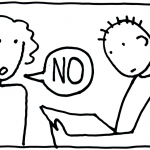When Prospects Say No

When a prospect says no or, worse, when they just don’t get back to you — which is the slow form of “no” — it’s very frustrating.
In one of my recent consultations, a client asked for advice on what to do in this situation. He’d had a series of proposals out to prospects and was wondering what he could do to turn them into clients.
The enemy in these uncomfortable situations is the eagerness to get past our feelings of discomfort. Nobody likes conflict and rejection. I have these feelings myself. I always thought I’d get past them with experience. I haven’t, but now I deal better with them.
That’s what I immediately wanted to help my client with and, if possible, help him close some new business in the process. Most of all, I sought to help him understand more clearly how his skills and experience can help his clients.
So, here we are. You’ve presented your case. The logic is sound, your credentials relevant. It’s clear that you understand the situation and know how to help them achieve their goals, at least to this point.
Reducing your fee or asking for a lower salary (if it’s employment you’re seeking), cutting deliverables, or shortening the schedule are not the answer. If you do any of those, you’ll undermine the value of your expertise.
The Tricky Part
When people say “no,” they are actually asking for help. Actually “no” is the start of the real negotiation, the beginning of the opportunity to understand their real needs.
“No” means:
- “I don’t want precisely what you described”
- “I can’t see any way to move forward”
- “I have other issues that I haven’t revealed”
- “I’m afraid to tell you what my real constraints are”
- And so on.
“No” is a signal that you don’t know the whole story yet. It means that you have not established a trusting, mutual problem-solving relationship — at least not yet. “No” is an opportunity to extend the relationship and expand your understanding of the problem. When you hear “no” it means: don’t give up now, you’re just getting to the good part.
So, start asking questions, in person or on a video call if a meeting is impossible. You should see them, and they you, to gain their trust. Their answers to the following questions will provide new insights. More importantly, this dialogue will show your interest in understanding the prospect and the situation from their point of view.
Pose questions like:
- What about this proposal is not right?
- What stands in the way?
- Is there anything else I could do to help?
- Is there something I didn’t understand?
- Has something changed in the interim?
- Are there others we should consult to refine the approach?
As you approach the “no” part of the negotiation, remember that we are social animals first. We need time in each other’s presence to begin to build understanding and trust. “No” just means your opposite reached a point where they don’t yet see how to move forward. It’s your opportunity to help them explore the possibilities.
You must demonstrate your interest in trying to uncover the potential. You don’t have to have all the answers. You do have to help them think a little more deeply about what they need and are looking for.
Every time you get a “no,” consider it an opportunity to explore ways to help. With some practice you’ll turn that “no” into a resounding “yes.”
This article originally appeared at PR Daily.


